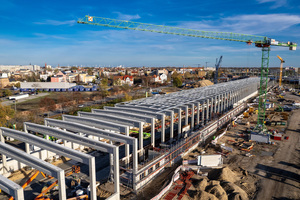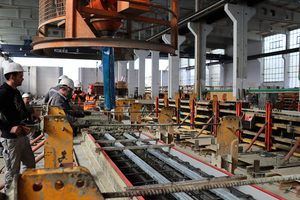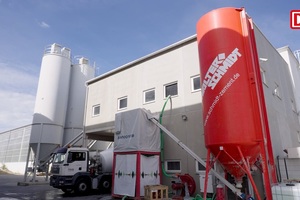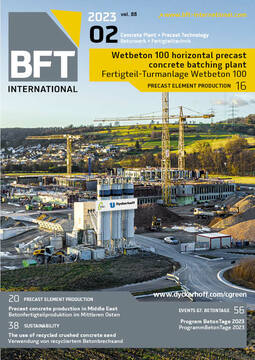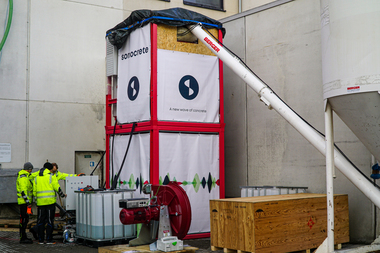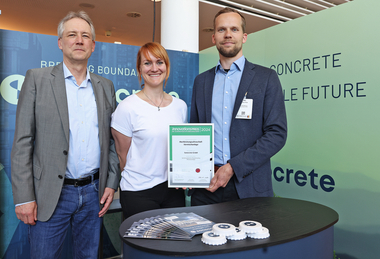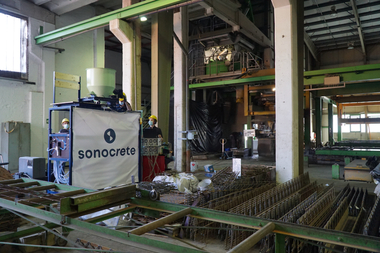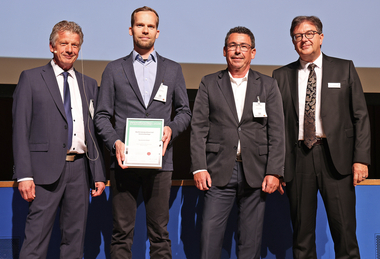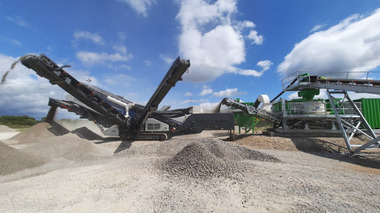Lusatian companies provide climate-friendly concrete
With the “Neues Werk Cottbus” project, Deutsche Bahn (DB) pushes towards sustainable mobility. The new maintenance plant will be DB’s largest and most modern to service ICE trains, and even during the construction of the plant, sustainability is at the centre stage. Therefore, together with the construction company Wayss & Freytag (W&F) and the concrete producer Hentschke Bau, DB relies on the innovative technology of the Cottbus-based startup Sonocrete to produce clinker-reduced concrete at similar early compressive strength.
Sonocrete’s newly developed ultrasonic mixing process was used in the production of the precast concrete elements for the new facility. The foundations, columns and girders were manufactured at Hentschke Bau’s concrete plant in Bautzen. With Sonocrete’s high power ultrasound technology to accelerate the hydration reaction, the parts could be produced with 30% less clinker than usual. Stripping times and early compressive strengths were not compromised. A 30% reduction in clinker content saves about 1.4 tons of carbon per girder.
How it started
At the end of 2021, the Sonocrete team was looking forward to a busy year with several prototype demonstrations to various concrete plants, all the while pitching their company to potential partners on a regular basis. One meeting exceeded everyone’s expectations. This was when Ricardo Remus, CEO of Sonocrete, and Nora Baum, CFO, met with the project manager of Deutsche Bahn’s new maintenance facility, Thomas Herr. 10 minutes into the meeting it was clear that Deutsche Bahn wants to work with Sonocrete and a couple of days later everything was decided and approved. In only ten minutes, Sonocrete had landed their biggest project yet – not only a demonstration of a prototype, but an actual production support for several months, producing the largest concrete elements so far, most of them prestressed.
But landing a project is just the first step. What followed was a lot of work for the team - from testing the concrete recipe on a small scale, optimizing it to reduce carbon emission, transporting the Sonocrete prototype to the concrete plant in Bautzen, to implementing the system into the concrete production process of the plant.
Long trial run for a prototype
As soon as the Sonocrete prototype arrived at Hentschke Bau in Bautzen, the team started to support the production of foundations, later columns and finally 20-meter-long prestressed girders that consume 18 to 20 m³ of concrete.
For this the Sonocrete prototype was used almost daily for nine weeks, enabling the production of more than 350 m³ of concrete. A significant challenge for the machine and the team alike: The prototype had never been running for such a long time, and the limits of previously assumed insignificant parts were reached every so often and needed fixing. Also, occasional minor mistakes, like a open valve that should have been closed, caused frustration amongst the team members on some days. But prototypes are meant to break and to show weaknesses, and all these incidences were great opportunities to learn and improve the system.
Dr.-Ing. Frank Jesse, Hentschke Bau GmbH: „What is perhaps special is that we were switching to green concrete in the middle of production, almost as an open-heart operation. Our claim is that we don’t have to throw away a single component for our client, everything works right from the start and all components also meet all quality standards.”
Low carbon concrete
After nine weeks of almost daily production in Bautzen, the teams of Sonocrete and Hentschke Bau were able to cut emissions of the concrete parts by 30%. This reduction was made possible by reducing the cement content of the concrete recipe and switching from Portland cement to a less reactive blended cement, thus decreasing the clinker content.
The produced foundations, columns, and girders met all quality standards and are now part of the new maintenance facility in Cottbus. Sonocrete is especially pleased to have successfully produced large low carbon prestressed parts like girders, as prestressed concrete production can pose an additional challenge.
This kind of success can only be reached with a great team – the cooperation between Hentschke Bau, Sonocrete, Wayss & Freytag and Deutsche Bahn was smooth, respectful, and driven by the will to push boundaries. As Dr.-Ing. Anja Sternberg from Wayss & Freytag puts it: “We’re trying something new here. We are putting something from research into practice and we have managed it very successfully.”
The solution to a burning problem
The Sonocrete process can help reduce the high carbon emissions of cement production, which account for about 8% of global carbon emissions. These are created during the production of the cement clinker, a crucial component of the cement. The production of cement clinker involves the decomposition of calcium carbonate in limestone by heating using fossil fuels to generate the extremely high burning temperatures.
The clinker content in cement is particularly critical for precast concrete plants. Here, highly reactive cements are used to achieve rapid early strength development in the concrete. Precast producers know: The faster the concrete moulds can be stripped, the better. With the high-performance ultrasonic mixing system developed by Sonocrete, the hydration reaction of the concrete is accelerated by inducing cavitation, which leads to better dispersion and faster formation of strength-giving C-S-H phases. This faster hydration allows precast producers to reduce clinker content while maintaining early strength and quality.
Sonocrete was founded by Dr. Ricardo Remus (CEO) and Dr. Christiane Rössler as a spin-off of the Bauhaus University Weimar in November 2018. The ultrasonic mixing process is based on 12 years of research and the Sonocrete system has been under continuous development for four years. The company now employs 20 people, mostly engineers from various disciplines, and will install the first devices in 2023 in several concrete plants in Germany.
Ricardo Remus, CEO of Sonocrete: “With Sonocrete, precast concrete production can take a big step towards sustainability by mixing concrete with less of the reactive material, the so-called cement clinker. This not only saves CO2, but also reduces costs. As a Cottbus-based startup, we are of course particularly pleased that building components made with the Sonocrete technology will soon be standing here. The produced girders were, because of their size alone, an exciting challenge for us. We’re proud to have successfully mastered this difficult task and are looking forward to all the projects to come.“

